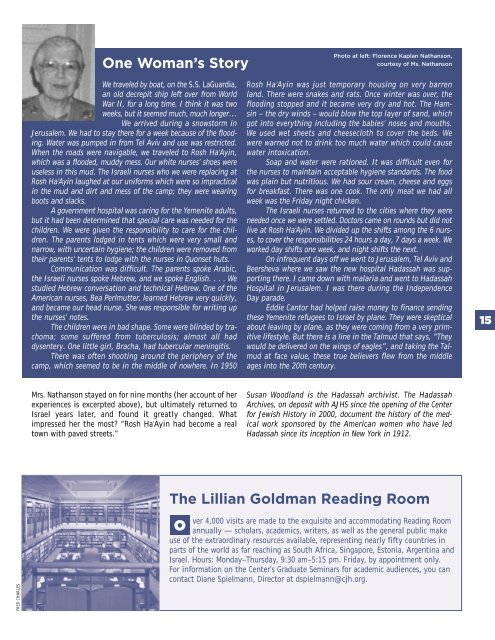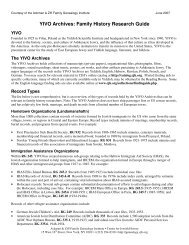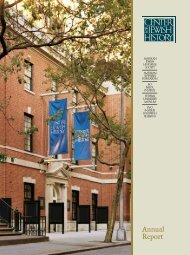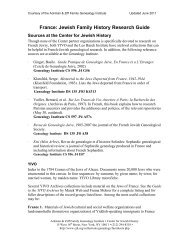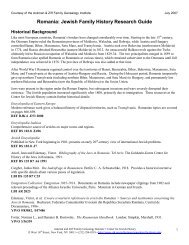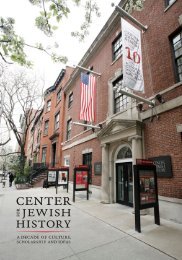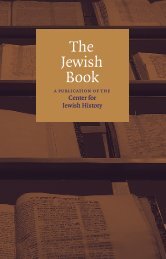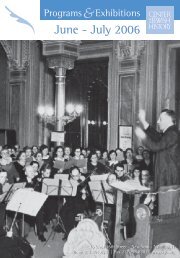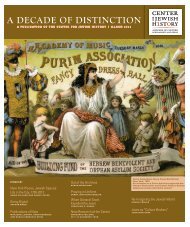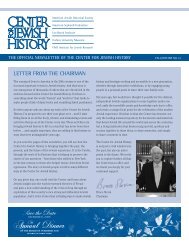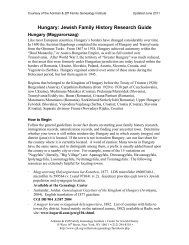ib singer ib singer ib singer ib singer ib singer - Center for Jewish ...
ib singer ib singer ib singer ib singer ib singer - Center for Jewish ...
ib singer ib singer ib singer ib singer ib singer - Center for Jewish ...
You also want an ePaper? Increase the reach of your titles
YUMPU automatically turns print PDFs into web optimized ePapers that Google loves.
FRED CHARLES<br />
One Woman’s Story<br />
We traveled by boat, on the S.S. LaGuardia,<br />
an old decrepit ship left over from World<br />
War II, <strong>for</strong> a long time. I think it was two<br />
weeks, but it seemed much, much longer…<br />
We arrived during a snowstorm in<br />
Jerusalem. We had to stay there <strong>for</strong> a week because of the flooding.<br />
Water was pumped in from Tel Aviv and use was restricted.<br />
When the roads were navigable, we traveled to Rosh Ha‘Ayin,<br />
which was a flooded, muddy mess. Our white nurses’ shoes were<br />
useless in this mud. The Israeli nurses who we were replacing at<br />
Rosh Ha‘Ayin laughed at our uni<strong>for</strong>ms which were so impractical<br />
in the mud and dirt and mess of the camp; they were wearing<br />
boots and slacks.<br />
A government hospital was caring <strong>for</strong> the Yemenite adults,<br />
but it had been determined that special care was needed <strong>for</strong> the<br />
children. We were given the respons<strong>ib</strong>ility to care <strong>for</strong> the children.<br />
The parents lodged in tents which were very small and<br />
narrow, with uncertain hygiene; the children were removed from<br />
their parents’ tents to lodge with the nurses in Quonset huts.<br />
Communication was difficult. The parents spoke Arabic,<br />
the Israeli nurses spoke Hebrew, and we spoke English. . . . We<br />
studied Hebrew conversation and technical Hebrew. One of the<br />
American nurses, Bea Perlmutter, learned Hebrew very quickly,<br />
and became our head nurse. She was respons<strong>ib</strong>le <strong>for</strong> writing up<br />
the nurses’ notes.<br />
The children were in bad shape. Some were blinded by trachoma;<br />
some suffered from tuberculosis; almost all had<br />
dysentery. One little girl, Bracha, had tubercular meningitis.<br />
There was often shooting around the periphery of the<br />
camp, which seemed to be in the middle of nowhere. In 1950<br />
Mrs. Nathanson stayed on <strong>for</strong> nine months (her account of her<br />
experiences is excerpted above), but ultimately returned to<br />
Israel years later, and found it greatly changed. What<br />
impressed her the most? “Rosh Ha‘Ayin had become a real<br />
town with paved streets.”<br />
Rosh Ha‘Ayin was just temporary housing on very barren<br />
land. There were snakes and rats. Once winter was over, the<br />
flooding stopped and it became very dry and hot. The Hamsin<br />
– the dry winds – would blow the top layer of sand, which<br />
got into everything including the babies’ noses and mouths.<br />
We used wet sheets and cheesecloth to cover the beds. We<br />
were warned not to drink too much water which could cause<br />
water intoxication.<br />
Soap and water were rationed. It was difficult even <strong>for</strong><br />
the nurses to maintain acceptable hygiene standards. The food<br />
was plain but nutritious. We had sour cream, cheese and eggs<br />
<strong>for</strong> breakfast. There was one cook. The only meat we had all<br />
week was the Friday night chicken.<br />
The Israeli nurses returned to the cities where they were<br />
needed once we were settled. Doctors came on rounds but did not<br />
live at Rosh Ha‘Ayin. We divided up the shifts among the 6 nurses,<br />
to cover the respons<strong>ib</strong>ilities 24 hours a day, 7 days a week. We<br />
worked day shifts one week, and night shifts the next.<br />
On infrequent days off we went to Jerusalem, Tel Aviv and<br />
Beersheva where we saw the new hospital Hadassah was supporting<br />
there. I came down with malaria and went to Hadassah<br />
Hospital in Jerusalem. I was there during the Independence<br />
Day parade.<br />
Eddie Cantor had helped raise money to finance sending<br />
these Yemenite refugees to Israel by plane. They were skeptical<br />
about leaving by plane, as they were coming from a very primitive<br />
lifestyle. But there is a line in the Talmud that says, “They<br />
would be delivered on the wings of eagles”, and taking the Talmud<br />
at face value, these true believers flew from the middle<br />
ages into the 20th century.<br />
The Lillian Goldman Reading Room<br />
O<br />
Photo at left: Florence Kaplan Nathanson,<br />
courtesy of Ms. Nathanson<br />
Susan Woodland is the Hadassah archivist. The Hadassah<br />
Archives, on deposit with AJHS since the opening of the <strong>Center</strong><br />
<strong>for</strong> <strong>Jewish</strong> History in 2000, document the history of the medical<br />
work sponsored by the American women who have led<br />
Hadassah since its inception in New York in 1912.<br />
ver 4,000 visits are made to the exquisite and accommodating Reading Room<br />
annually — scholars, academics, writers, as well as the general public make<br />
use of the extraordinary resources available, representing nearly fifty countries in<br />
parts of the world as far reaching as South Africa, Singapore, Estonia, Argentina and<br />
Israel. Hours: Monday–Thursday, 9:30 am–5:15 pm. Friday, by appointment only.<br />
For in<strong>for</strong>mation on the <strong>Center</strong>’s Graduate Seminars <strong>for</strong> academic audiences, you can<br />
contact Diane Spielmann, Director at dspielmann@cjh.org.<br />
15


